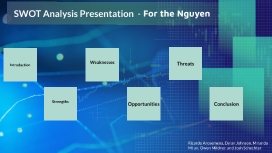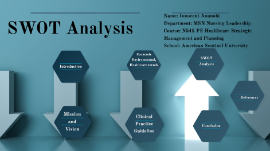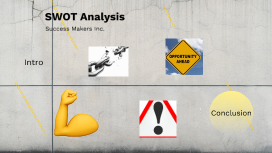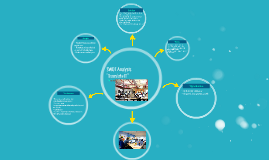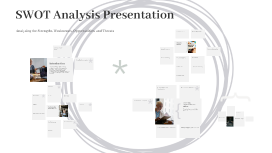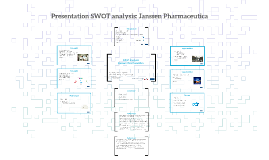SWOT Analysis Presentation
Transcript: SWOT Analysis Presentation Market Adaptability Competitive Advantages Analyzing the Strengths, Weaknesses, Opportunities, and Threats Market adaptability reflects the company's ability to adjust to changing market conditions, trends, and consumer preferences to maintain relevance and competitiveness. Competitive advantages are unique strengths possessed by a company that sets it apart from its competitors. Strengths Analysis Overview of SWOT Analysis This section explores the internal advantages and positive attributes of the chosen company to understand its strengths. Unique Resources Strategic Partnerships Unique resources refer to distinctive assets or capabilities that provide a competitive edge to the company. Strategic partnerships involve collaborations with other businesses to enhance capabilities, access new markets, and create mutually beneficial opportunities. SWOT analysis involves identifying internal strengths and weaknesses to leverage opportunities and mitigate threats externally. This strategic framework aids in understanding the competitive landscape and guiding decision-making processes effectively. Market Leadership Financial Stability Brand Reputation Title and Student Information Market leadership signifies a company's dominant position in the industry, often due to superior products, services, or brand reputation. Financial stability indicates a company's ability to maintain a strong financial position, withstand market fluctuations, and invest in growth opportunities. Brand reputation represents the perception of the company in the market, influencing customer trust, brand loyalty, and market positioning. Introduction Include the title of the assignment, student's name, school, course, instructor, and date for proper identification. Ensure all details are accurately presented for academic integrity and recognition. Operational Efficiency Innovative Culture Operational efficiency entails optimizing processes, reducing costs, and maximizing productivity to enhance the company's performance and profitability. An innovative culture fosters creativity, continuous improvement, and the development of cutting-edge products or services within the company. The SWOT Analysis tool provides a strategic framework for assessing a company's internal strengths and weaknesses, along with external opportunities and threats. This analysis is essential for making informed business decisions. Customer Loyalty Customer loyalty reflects a strong bond between the company and its customers, leading to repeat business, positive word-of-mouth, and sustainable growth. Weaknesses Threat Assessment and Mitigation Strategic Partnership Opportunities Weaknesses are internal factors that hinder a company's progress. These could include poor management, lack of innovation, or high employee turnover. Conducting a thorough analysis of potential threats such as regulatory changes, economic downturns, and cybersecurity risks is essential for effective risk management. Developing risk mitigation strategies and contingency plans can safeguard the company's operations and reputation. Collaborating with industry leaders, startups, or complementary businesses can open doors to new markets, technologies, and resources. Strategic partnerships foster mutual growth and enable shared expertise to drive innovation and sustainable business success. Opportunities References Strengths Opportunities are external factors that could benefit the company. Examples include market growth, new partnerships, or advancements in technology. Ensure to cite all sources used in the SWOT analysis to maintain credibility and transparency in the strategic planning process. References play a crucial role in validating the data and insights presented in the analysis. Strengths are internal factors that give a company a competitive advantage. This could include a strong brand, loyal customer base, or proprietary technology. Innovative Product Development Conclusion Threats Uncovering Opportunities and Threats Investing in research and development to create innovative products and services can differentiate the company from competitors and attract a loyal customer base. Continuous innovation is essential to staying ahead in the dynamic market landscape. Outdated Technology Infrastructure The SWOT diagram is a valuable tool for companies to assess their internal and external environment, identify key factors affecting their business, and make informed strategic decisions. By understanding their strengths, weaknesses, opportunities, and threats, companies can plan effectively for the future. Threats are external factors that could pose challenges to the company's success. These could be economic downturns, new competitors, or changing regulations. Understanding SWOT Diagram Obsolete technology infrastructure can hinder operational efficiency, innovation, and responsiveness to market dynamics, impacting long-term sustainability and growth. Limited Product






